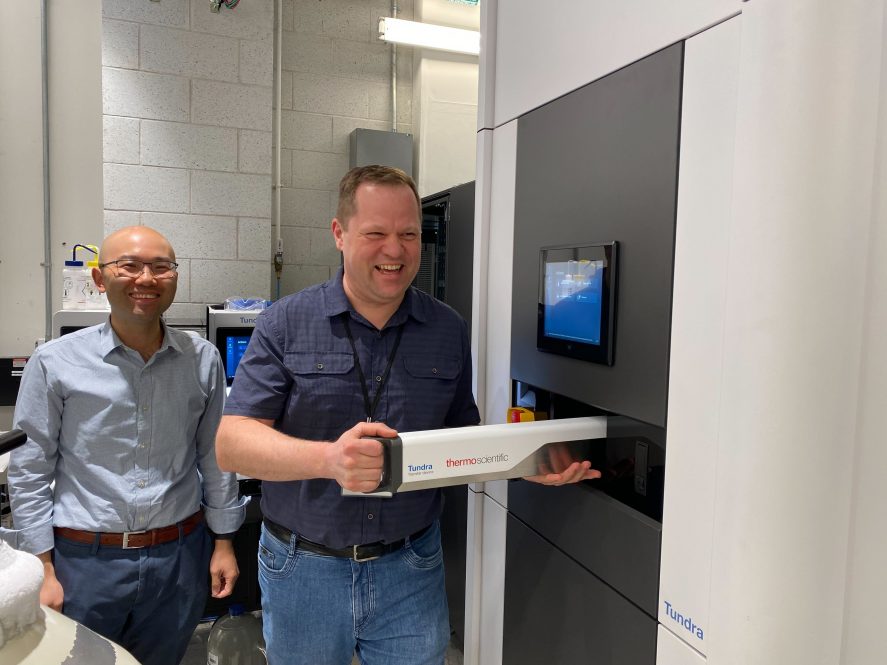Wolfgang Peti, professor in UConn School of Medicine’s Department of Molecular Biology and Biophysics, has recently obtained a $1.5 million grant from the National Institutes of Health (NIH) through their National Institute of General Medical Sciences (NIGMS) and the Office of the Director (OD). He is using it to purchase a new state-of-the-art cryo-electron microscope that analyzes samples at below-freezing temperatures. Key for successful funding was a strong collaboration between UConn Health, UConn, UMass Amherst, and Wesleyan University. Additionally, Dr. Jianbin Ruan, assistant professor in UConn School of Medicine’s Department of Immunology, Dr. Rebecca Page, professor in UConn School of Medicine’s Department of Cell Biology, and Dr. Meng Choy and Dr. Satish Padi, both assistant professors-in-residence in UConn School of Medicine’s Department of Molecular Biology and Biophysics, have been critical contributors to this important effort.
Cryogenic electron microscopy, or cryo-EM, allows scientists to gain a three-dimensional picture of the molecules they are studying. It’s one of the three most-used imaging techniques for structural biology, according to Peti. The two others, crystallography and nuclear magnetic resonance (NMR) spectroscopy, are already in use at UConn Health.
“When you see something, it’s much easier to understand,” says Peti. “That’s the attraction of structural biology — really understanding something, both the overall look and the chemistry that it’s doing. Ultimately, we can then use it for drug design and essential translational research problems.”
There are different levels of cryo-EM instruments, Peti explains, and the new instrument in Farmington will fill a critical gap in the New England research corridor. The highest-powered cryo-EM machines currently accessible in national facilities are even more expensive to acquire, and they require researchers to have ready-to-go samples to be able to use them. The machine in Farmington, in contrast, will be more accessible, opening its exciting molecular imaging technology to more scientists across the region and at UConn. It will also allow its users to obtain these ready-to-go samples to utilize the higher-powered machines by ensuring they have properly prepared their samples.
It will allow all of our students and coworkers to learn the technique. We can become experts.
Peti is excited about the technology’s relevance for UConn Health — its researchers, its students, and eventually its patients.
“It will allow all of our students and coworkers to learn the technique,” he says. When samples had to be analyzed at external facilities, students didn’t get the opportunity to observe and participate in the imaging process themselves. “Now we can use it. We can become experts.”
After the new machine is acquired and installed, it will be used for structural biology analyses of human, animal, and viral samples. One of Peti’s chief research interests is cell cycle regulation, specifically the functions of proteins within the cell that serve as “critical timing machines.” In-house cryo-EM imaging will further enable his research into the structure and function of these proteins.
“If anything goes wrong there, it leads to cancer,” he explains. “That’s why we are interested in understanding how they are working.”
Cryo-EM is a necessary addition to UConn Health’s cutting-edge research facilities, says Peti. Having the full suite of microscopic imaging capabilities — cryo-EM, crystallography, and NMR spectroscopy — will ensure that the university can perform competitive research for decades to come.
“If you want to be doing really good research, you have to be able to use all the complementary techniques. The advantages of this technique are clear — it requires an extremely small amount of sample to use,” he says.
The selected cryo-EM instrument, the “Tundra,” will also be one of the first Tundra cryo-EM microscopes in the nation to be acquired with NIH funding.
“We’re really at the forefront there,” Peti says.



